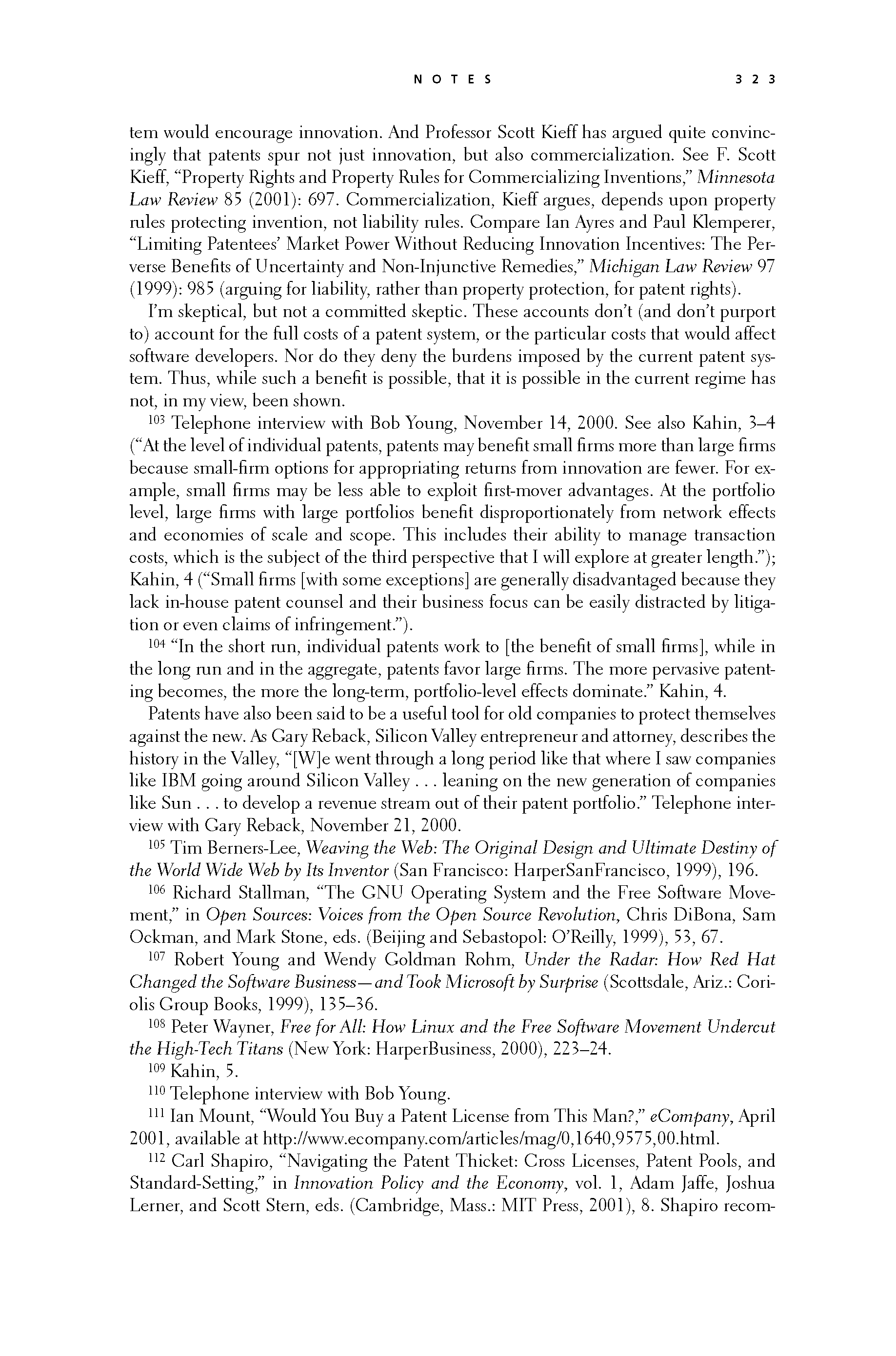 p322 _
-chap- _
toc-1 _
p323w _
toc-2 _
+chap+ _
p324
p322 _
-chap- _
toc-1 _
p323w _
toc-2 _
+chap+ _
p324
tem would encourage innovation. And Professor Scott Kieff has argued quite convinc-
ingly that patents spur not just innovation, but also commercialization. See F. Scott
Kieff, "Property Rights and Property Rules for Commercializing Inventions," _Minnesota_
_Law_Review_ 85 (2001): 697. Commercialization, Kieff argues, depends upon property
rules protecting invention, not liability rules. Compare Ian Ayres and Paul Klemperer,
"Limiting Patentees' Market Power Without Reducing Innovation Incentives: The Per-
verse Benefits of Uncertainty and Non-Injunctive Remedies," _Michigan_Law_Review_ 97
(1999): 985 (arguing for liability, rather than property protection, for patent rights).
I'm skeptical, but not a committed skeptic. These accounts don't (and don't purport
to) account for the full costs of a patent system, or the particular costs that would affect
software developers. Nor do they deny the burdens imposed by the current patent sys-
tem. Thus, while such a benefit is possible, that it is possible in the current regime has
not, in my view, been shown.
[11-103] Telephone interview with Bob Young, November 14, 2000. See also Kahin, 3-4
("At the level of individual patents, patents may benefit small firms more than large firms
because small-firm options for appropriating returns from innovation are fewer. For ex-
ample, small firms may be less able to exploit first-mover advantages. At the portfolio
level, large firms with large portfolios benefit disproportionately from network effects
and economies of scale and scope. This includes their ability to manage transaction
costs, which is the subject of the third perspective that I will explore at greater length.");
Kahin, 4 ("Small firms [with some exceptions] are generally disadvantaged because they
lack in-house patent counsel and their business focus can be easily distracted by litiga-
tion or even claims of infringement.").
[11-104] "In the short run, individual patents work to [the benefit of small firms], while in
the long run and in the aggregate, patents favor large firms. The more pervasive patent-
ing becomes, the more the long-term, portfolio-level effects dominate." Kahin, 4.
Patents have also been said to be a useful tool for old companies to protect themselves
against the new. As Gary Reback, Silicon Valley entrepreneur and attorney, describes the
history in the Valley, "[W]e went through a long period like that where I saw companies
like IBM going around Silicon Valley... leaning on the new generation of companies
like Sun... to develop a revenue stream out of their patent portfolio." Telephone inter-
view with Gary Reback, November 21, 2000.
[11-105] Tim Berners-Lee, _Weaving_the_Web:_The_Original_Design_and_Ultimate_Destiny_of_
_the_World_Wide_Web_by_Its_Inventor_ (San Francisco: HarperSanFrancisco, 1999), 196.
[11-106] Richard Stallman, "The GNU Operating System and the Free Software Move-
ment," in _Open_Sources:_Voices_from_the_Open_Source_Revolution,_ Chris DiBona, Sam
Ockman, and Mark Stone, eds. (Beijing and Sebastopol: O'Reilly, 1999), 53, 67.
[11-107] Robert Young and Wendy Goldman Rohm, _Under_the_Radar:_How_Red_Hat_
_Changed_the_Software_Business_--_and_Took_Microsoft_by_Surprise_ (Scottsdale, Ariz.: Cori-
olis Group Books, 1999), 135-136.
[11-108] Peter Wayner, _Free_for_All:_How_Linux_and_the_Free_Software_Movement_Undercut_
_the_High-Tech_Titans_ (New York: HarperBusiness, 2000), 223-224.
[11-109] Kahin, 5.
[11-110] Telephone interview with Bob Young.
[11-111] Ian Mount, "Would You Buy a Patent License from This Man?," _eCompany,_ April
2001, available at http://www.ecompany.com/articles/mag/0,1640,9575,00.html.
[11-112] Carl Shapiro, "Navigating the Patent Thicket: Cross Licenses, Patent Pools, and
Standard-Setting," in _Innovation_Policy_and_the_Economy,_ vol. 1, Adam Jaffe, Joshua
Lerner, and Scott Stern, eds. (Cambridge, Mass.: MIT Press, 2001), 8. Shapiro recom-
[[323]]
p322 _
-chap- _
toc-1 _
p323w _
toc-2 _
+chap+ _
p324